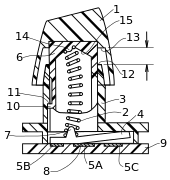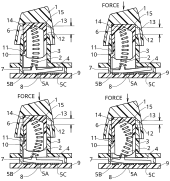Buckling spring


A buckling spring is a type of keyswitch mechanism, popularized by IBM's keyboards for the PC, PC/AT, 5250/3270 terminals, PS/2, and other systems. It was used by IBM's Model F keyboards (for instance the AT keyboard), and the more common Model M. It is described in U.S. patent 4,118,611 (Model F) and U.S. patent 4,528,431 (Model M), both now expired.
Operation
The coil spring tensed between the keycap and a pivoting hammer buckles (i.e. kinks or collapses) at a certain point in its downward traverse, providing auditory and tactile feedback to the keyboard operator. Upon buckling, the hammer is pivoted forward by the spring and strikes an electrical contact which registers the key press. In a Model M, the electrical contact is a membrane sheet similar to that of a modern dome switch keyboard.
Gallery
-
Buckling spring on key press and release
-
Illustration from the original buckling spring U.S. patent 4,118,611, issued to IBM in 1978
-
A drawing included in the patent for the buckling spring mechanism
-
Graph of key force over key travel for a buckling spring key. Visible in graph position 1C the fast force drop when the spring buckles. U.S. patent 4,118,611, issued to IBM in 1978.
See also
References
External links
- Wiki article on the various buckling spring mechanisms – From deskthority.net





